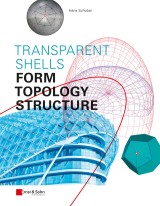Details

Transparent Shells
Form, Topology, Structure1. Aufl.
|
88,99 € |
|
| Verlag: | Ernst & Sohn |
| Format: | |
| Veröffentl.: | 22.12.2015 |
| ISBN/EAN: | 9783433606001 |
| Sprache: | englisch |
| Anzahl Seiten: | 272 |
DRM-geschütztes eBook, Sie benötigen z.B. Adobe Digital Editions und eine Adobe ID zum Lesen.
Beschreibungen
This book describes the design, detailing and structural engineering of filigree, double-curved and long-span glazed shells of minimal weight and ingenious details. <p>Innovative, clear and understandable geometric principles for the design of double-curved shell structures are explained in a practical manner. The principles are simple to apply with the use of functions now available in most CAD programs. The author demonstrates how floating and homogeneous structures can be created on these "free" forms, particularly grid shells of planar rectangles. These are especially suitable for glazing with flat panes and offer structural, economical and architectural advantages. Examples are provided to illustrate in simple ways the latest methods of form finding calculation and holistic optimisation through the complex interaction of structure, form and topology.</p> <p>Numerous examples built all over the world from 1989 to 2014 offer orientation and assistance in the design of such double-curved shells. Essential design parameters, many details and node connections of constructed projects are presented and evaluated. These structures have been built all over the world in close partnership with renowned architects.</p>
<p>Foreword 6</p> <p>Preface 6</p> <p>Acknowledgements 8</p> <p>About the Author 9</p> <p>With the collaboration of 10</p> <p><b>1 Introduction to shells 13</b></p> <p>1.1 Designing shells 14</p> <p><b>2 History 19</b></p> <p>2.1 Historical examples 20</p> <p><b>3 Design principle of grid shells 31</b></p> <p>3.1 Development of the design principle 32</p> <p>3.2 Construction of the grid shells in Neckarsulm and in Hamburg 40</p> <p><b>4 Graphic design principles for grid shells with flat quadrilateral meshes 49</b></p> <p>4.1 Graphic design principles for translational surfaces 51</p> <p>4.2 The barrel vault as simplest translational surface 53</p> <p>4.2.1 Optimum section curve 55</p> <p>4.2.2 Bracing of barrel vaults 56</p> <p>4.2.3 The barrel-vault according to the Zollinger construction method 63</p> <p>4.3 Surface of revolution 64</p> <p>4.3.1 Array of surfaces of revolution 67</p> <p>4.3.2 One-dimensional scaling and rotation 70</p> <p>4.4 Domes as translational surfaces 72</p> <p>4.4.1 Optimum rise of domes 73</p> <p>4.4.2 Examples on dome-like translational surfaces 74</p> <p>4.4.3 Arrayed translational surfaces 79</p> <p>4.5 Hyperbolic paraboloid with flat quadrilateral meshes 80</p> <p>4.5.1 On the load bearing behaviour of hypar-shells with straight edges 82</p> <p>4.5.2 The hypar as translational surface with flat quads 84</p> <p>4.5.3 The hypar as ruled surface with flat quadrangles 87</p> <p>4.5.4 Equation of the hypar at given 4 straight edges 91</p> <p>4.5.5 Cut-outs from the hypar surface along the generating lines 94</p> <p>4.5.6 Array of hypar surfaces 101</p> <p>4.5.7 Rain water drainage of 'flat'’ surfaces 112</p> <p>4.6 'Skew' translation 113</p> <p>4.7 Graphic design principle for scale-trans surfaces 122</p> <p>4.7.1 Scaling of spatial curves 122</p> <p>4.7.2 Scale-trans surfaces 124</p> <p>4.8 Lamella surfaces with flat quadrangular meshes 132</p> <p>4.8.1 The regular lamella surface 135</p> <p>4.8.2 Cut-outs from lamella surfaces 136</p> <p>4.9 Scaling of double-curved surfaces with flat quadrangular meshes 137</p> <p>4.10 Application for spatial sheet metal constructions 140</p> <p>4.11 Application for formwork in concrete construction 142</p> <p><b>5 Free formed grid shells 147</b></p> <p>5.1 Grid shells with flat quadrangular meshes based on free-forms 149</p> <p>5.2 Grid shells with warped quadrangular meshes 150</p> <p>5.3 Combination of flat quadrangular and triangular meshes 154</p> <p><b>6 Form-finding and optimisation of grid shells 161</b></p> <p>6.1 Form-finding on the inverted hanging model 163</p> <p>6.2 Form-finding with membrane elements 165</p> <p>6.3 Form-finding based on dynamic relaxation and the force density method 168</p> <p>6.4 Holistic 'form-finding' using shape optimisation 175</p> <p><b>7 On the structural design of grid shells 185</b></p> <p>7.1 Structural analysis of glazing 186</p> <p>7.2 Analysis of the structure 186</p> <p><b>8 Built examples 189</b></p> <p>8.1 List of glazed shells 190</p> <p>8.2 Node connections 208</p> <p>8.2.1 Introduction 208</p> <p>8.2.2 Bolted nodes 214</p> <p>8.2.3 Welded nodes 229</p> <p><b>9 Holistic design – developments and outlook 239</b></p> <p>Bibliography 250</p> <p>Bibliography on projects 251</p> <p>List of projects 252</p> <p>Picture credits 254</p> <p>Imprint 256</p>
This book draws on the author's contemplations and experiences, and includes his descriptions of recent developments in the field of transparent shell structures. He gathered these during his time with the engineering firm schlaich bergermann und partner.<br /> Dr.-Ing. <b>Hans Schober</b> graduated in Structural Engineering at the University of Stuttgart, before joining schlaich bergermann und partner in 1982. In 1992 he became a partner at the Stuttgart headquarters, then taking over the position of managing director of the New York branch in 2005. In 2009 he then returned to Stuttgart as partner at sbp until 2013. Since then he has worked as a consultant. As a student of Jörg Schlaich he devoted his time to pedestrian and railway bridges; focusing particularly on the design of filigree transparent shells and stressed cable net facades. On various projects he worked in collaboration with a number of internationally renowned architects including, amongst others, F. O. Gehry, Meinhard von Gerkan und Volkwin Marg (gmp), Rafael Vinoly, Hani Rashid (asymptote), David Childs (SOM), James Carpenter, I. M. Pei, Cesar Pelli, Massimiliano Fuksas, and Shigeru Ban.

















